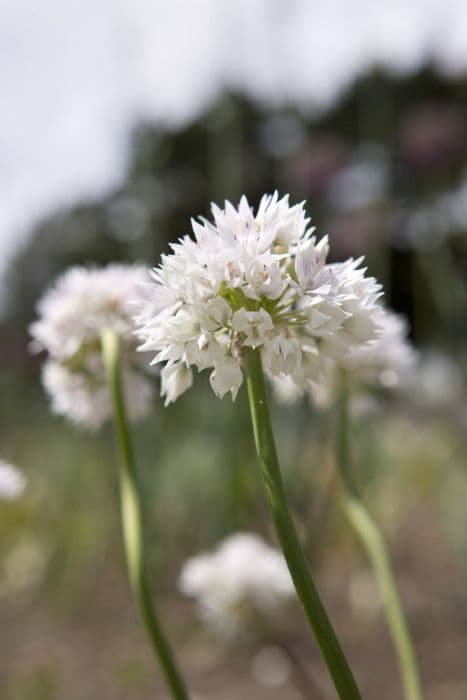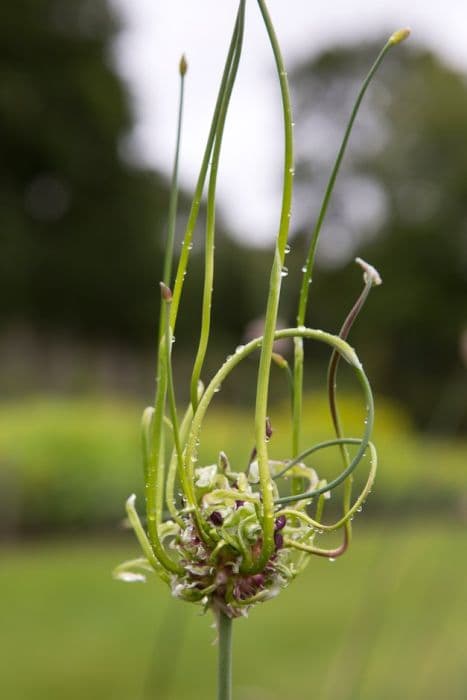Nodding Onion Allium cernuum 'Hidcote'
ABOUT
The Allium cernuum 'Hidcote', commonly known as the nodding onion, is recognized for its unique, charming flowers and foliage. The plant showcases attractive, grass-like leaves that are glossy and create a lush base for the ornamental blooms. The leaves may gently droop or arch, adding to its graceful silhouette. The most striking feature of the nodding onion is its flowers. They bloom in clusters that hang from the top of long, slender stems, creating a nodding effect—hence its name. These flowers are usually a soft shade of pink, though they can sometimes be found in lighter or darker variations, creating a delicate and whimsical display. These charming umbels consist of numerous small, bell-shaped flowers. Each individual flower is composed of pointed petals that curve back, revealing the stamen and pistil at the center. When in full bloom, these flower clusters resemble a loose, airy chandelier, offering a delightful visual appeal in the garden setting. As the seasons change, the blooms eventually give way to seed heads that can also be quite ornamental. These round capsules add another layer of interest to the plant as they persist into the later months of the year. The nodding onion is not only a visual treat but it's also a hardy plant that's adaptable to a range of growing conditions. It can attract pollinators such as bees and butterflies, further enhancing its allure in the landscape. The combination of its elegant foliage and pendulous flowers makes it a popular choice for gardeners seeking to add a touch of elegance and natural beauty to their gardens.
About this plant
 Names
NamesFamily
Amaryllidaceae.
Synonyms
Nodding Onion, Lady's Leek, Hidcote.
Common names
Allium cernuum
 Toxicity
ToxicityTo humans
Nodding onion (Allium cernuum 'Hidcote') is not known to be toxic to humans. In fact, many Allium species are edible and used in cooking for their flavor. However, it is always important to be sure of the identity of wild plants before consuming them, as some plants can be easily mistaken for non-edible and potentially toxic species.
To pets
Nodding onion (Allium cernuum 'Hidcote') is toxic to pets, especially cats and dogs. This plant contains substances that can cause oxidative damage to red blood cells, leading to conditions such as hemolytic anemia. The symptoms of poisoning in pets may include vomiting, diarrhea, abdominal pain, elevated heart and respiratory rates, weakness, exercise intolerance, and in severe cases, collapse. If you suspect your pet has ingested any part of this plant, it is important to seek veterinary care immediately.
 Characteristics
CharacteristicsLife cycle
Perennials
Foliage type
Deciduous
Color of leaves
Green
Flower color
Pink
Height
1-2 feet (30-60 cm)
Spread
0.5-1 feet (15-30 cm)
Plant type
Bulb
Hardiness zones
4
Native area
North America
Benefits
 General Benefits
General Benefits- Attracts Pollinators: The nodding onion, as it's commonly known, attracts important pollinators such as bees and butterflies to the garden.
- Drought Tolerant: Once established, Allium cernuum 'Hidcote' can tolerate periods of dryness, making it suitable for xeriscaping.
- Decorative Flowers: It produces attractive, bell-shaped flowers that add aesthetic appeal to landscaping and can be used in cut flower arrangements.
- Edible Parts: The leaves and bulbs are edible, adding a mild, onion-like flavor to culinary dishes.
- Low Maintenance: It's a hardy perennial that requires minimal care once established, making it ideal for busy gardeners.
- Wildlife Habitat: Provides food and habitat for various species of wildlife.
- Ground Cover: The plant can serve as a ground cover, reducing weed growth and soil erosion.
- Cold Hardy: It is capable of surviving in colder climates, making it a versatile choice for many gardens.
 Medical Properties
Medical PropertiesThis plant is not used for medical purposes.
 Air-purifying Qualities
Air-purifying QualitiesThis plant is not specifically known for air purifying qualities.
 Other Uses
Other Uses- As an ornamental border plant: Allium cernuum 'Hidcote' can be planted in small groups along the edges of a garden to provide a delicate, decorative touch with its nodding blooms.
- In rock gardens: This particular variety can be used to add height and texture to rock garden arrangements, where its slender stems contrast with the solidity of rocks and alpine plants.
- As a natural pest deterrent: The strong scent of Allium cernuum 'Hidcote' can help repel certain garden pests, making it a beneficial companion plant in vegetable gardens or ornamental beds.
- For cut flowers: The delicate, bell-shaped flowers make it a unique addition to floral arrangements and can be used in cut flower bouquets for a touch of whimsy.
- As plant dye: The flowers and leaves of the nodding onion can be used to create natural dyes for fabric, yielding various shades depending on the mordant used.
- Photographic subject: With its distinctive and attractive blooms, nodding onion can be a favorite subject for photographers specializing in botanical and garden photography.
- In lunar gardens: As a plant that can reflect the moonlight with its light-colored flowers, Allium cernuum 'Hidcote' is suitable for nighttime or lunar gardens designed to be enjoyed after dusk.
- For culinary decoration: The flowers can be used as a garnish for various dishes, adding a subtle onion flavor and a decorative touch to salads and soups.
- In potpourris: The dried flowers and leaves can contribute to potpourri mixes, adding fragrance and visual appeal to the mixture.
- As a ground cover: When planted densely, nodding onion can serve as a low-maintenance ground cover, effectively filling spaces and suppressing weeds with its foliage.
Interesting Facts
 Feng Shui
Feng ShuiThe Nodding Onion is not used in Feng Shui practice.
 Zodiac Sign Compitability
Zodiac Sign CompitabilityThe Nodding Onion is not used in astrology practice.
 Plant Symbolism
Plant Symbolism- Strength and Patience: The sturdy stems and resilient nature of the nodding onion, as Allium cernuum 'Hidcote' is commonly known, symbolize strength and the patience required to endure and overcome challenges.
- Unity and Humility: The clustered bulb characteristic of the nodding onion represents unity, as it grows in groups, and humility, due to its nodding flower heads that bow gracefully.
- Prosperity: Alliums in general are often associated with prosperity and abundance, which can extend to the nodding onion variety as well.
- Protection: Historically, alliums have been believed to offer protection against evil spirits and bad luck, a quality sometimes attributed to the nodding onion in folk traditions.
- Good Health: Many allium species are known for their culinary and medicinal properties, and nodding onions may carry the symbolism of well-being and good health.
 Water
WaterThe nodding onion should be watered deeply once a week, allowing the soil to dry out between watering sessions to prevent root rot. During the active growing season in the spring and summer, water using approximately one gallon per plant per week, depending on the weather and soil conditions. In the fall and winter, as the plant goes dormant, reduce watering frequency. If rain provides sufficient moisture, supplemental watering may not be necessary. Always check the top inch of the soil; if it feels dry to the touch, it's time to water again.
 Light
LightThe nodding onion thrives best in full sunlight to partial shade. A spot that receives at least six hours of direct sunlight daily is ideal for this plant. However, it can also tolerate light shade, especially in the afternoon if in a very hot or dry climate, but its blooming may be less prolific in less light.
 Temperature
TemperatureNodding onion prefers a temperature range between 60°F and 75°F for optimal growth but can tolerate temperatures as low as 5°F and as high as 90°F. The plant is cold-hardy and can survive winter chills, making it suitable for a wide range of climates. It's important to protect it from extreme heat and frost to maintain its health and ensure flowering.
 Pruning
PruningPrune the nodding onion to remove spent flower stalks and encourage a tidier appearance. Pruning is best done after the flowers have faded, typically in late summer or early fall. Occasional removal of damaged or yellowing leaves is also recommended to keep the plant healthy. Pruning is not required for plant health, but it can stimulate a second flush of growth in some cases.
 Cleaning
CleaningAs needed
 Soil
SoilNodding onion grows best in well-draining soil with a pH of 6.0-7.0, enriched with organic matter like compost. A mix of equal parts garden soil, compost, and sharp sand is ideal.
 Repotting
RepottingNodding onion rarely needs repotting; do so only if it outgrows its pot, typically every 3-4 years during dormancy.
 Humidity & Misting
Humidity & MistingNodding onion thrives in average outdoor humidity levels, without needing special humidity adjustments.
 Suitable locations
Suitable locationsIndoor
Ensure full sun, well-draining soil, and infrequent water for nodding onion.
Outdoor
Plant in well-drained soil, full sun, and space bulbs 4-6 inches apart.
Hardiness zone
4-8 USDA
 Life cycle
Life cycleNodding Onion (Allium cernuum 'Hidcote') begins its life as a seed, which germinates in spring when soil temperatures and moisture levels become favorable. The seedling then develops into a small bulb, which will go dormant during the winter months. In the following growing season, the bulb sends up strap-shaped leaves and a flower stalk that curves at its tip, nodding down to give the plant its common name. The flower stalk bears an umbel of pink to lilac flowers through the summer, which are attractive to pollinators and may lead to seed production if successfully pollinated. After flowering, the plant goes back into dormancy, during which the foliage dies back and the bulb overwinters underground. In subsequent years, the plant will continue this growth cycle, potentially dividing to form clumps of bulbs, enabling the spread and increased density of the nodding onion in the garden or wild area where it is growing.
 Propogation
PropogationPropogation time
Spring to early summer
Propogation: The Allium cernuum, commonly known as the nodding onion, is most popularly propagated by division, which is ideally done in the spring or fall. To propagate nodding onions by division, carefully dig up the plant, making sure to keep a good amount of soil around the roots to reduce stress. Gently separate the bulbs, ensuring that each division has at least one growth point or shoot. Replant the divisions immediately at the same depth they were growing before, spaced approximately 6 to 8 inches (15 to 20 centimeters) apart to allow for adequate growing room. Water the newly planted divisions well to help establish them. This vegetative method of propagation is advantageous as it maintains the genetic consistency of the plant and rapidly increases the number of plants you can cultivate.









